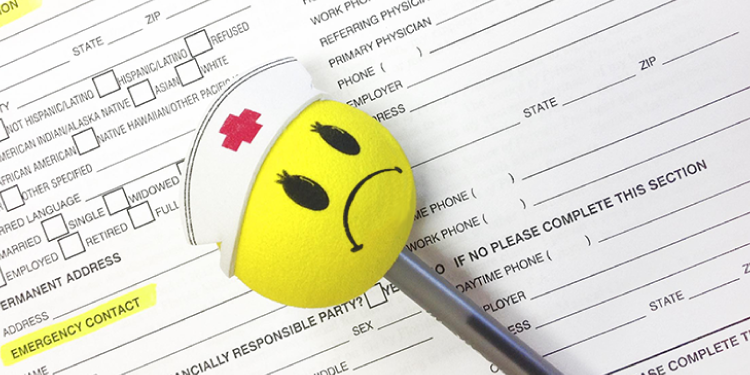At my son’s physical, we noticed a weird thing and were referred to a dermatologist. (I’m happy to report there is nothing wrong.)
But this is not the story of the actual medical diagnosis.
This is the story of what’s wrong with how patients are treated and just one of the ways the experience is broken.
We arrived just in time for a 3:40 pm appointment. We had never been to this office, but since they are connected to our pediatrician’s practice, they had most of our information “in the system.” Dragging the 8 year old and 11 year old into a doctor’s office after full days of camp isn’t appealing on any day, so I had prepped with snacks and books for our wait.
We were greeted by a friendly-enough front desk receptionist, who confirmed the information in the system. Then I was handed those forms on a clipboard.

Who in their right mind decided that copy after copy after no-longer-straight copy was an acceptable way to start the experience?
And I was baffled, yet again, when they handed me a completely blank history form to complete, including filling in the date of the appointment and the name, address, etc. of the patient.
I also mentioned we didn’t know which doctor we were seeing.
I was reminded to bring back the clipboard and pen.
I looked at the forms thinking maybe the doctor’s name was listed there. But it wasn’t. When I did return the completed forms, clipboard and pen, I was told I keep the forms.
I started noticing several people fretting about forgetting these forms with some delicate information scribbled on them. One woman shuffled hurriedly from the restroom and found her forms back on the couch, breathing an audible sigh of relief.

The waiting room, I should mention, was filled with an older crowd. Several patients couldn’t hear or even move very well. I know this because the announcement of who’s next sometimes took several attempts. The nurse would ask for “Jerome” and a very nice woman named Joan would stand up and cross the room, only to be told she had to sit down again.
The clock ticked away and my kids quickly grew tired of their empty snack containers and finished several chapters in their books. The sign behind the desk read “If you have waited 15 min past your appt time, please come tell us.”
I thought about it briefly. But by 30 minutes I was defeated. The room was filled with people who were there before we arrived. They were just running late.

Running this far behind must be so commonplace the staff there doesn’t even notice any more. Nobody mentioned they were running late to set expectations for our 45 minute wait in the waiting room. The nurse who walked us in never mentioned it. I kept waiting for an acknowledgement, an apology even? But nothing.
After we were shown to the room, we waited another 15 minutes.
Then a very nice doctor introduced herself to us and took a quick look. At that point, she said the doctor would be in in a few minutes. I believe she was a doctor. Maybe she was learning, which I have no problem supporting. But again, no communication leaves us wondering what will happen next.
In another few minutes, the first doctor, the other doctor and a medical student enter the room. Again, I am fully supportive of teaching environments in healthcare, but setting expectations should be part of that for the patients.
The actual appointment, and what some would isolate as the actual healthcare, was very good. I felt it was thorough and we got what we needed in the few minutes we spent dealing with the issues that brought us there.
We left that appointment after more than an hour and a half, with not one person acknowledging the wait or the inconvenience.
This is so common in our healthcare system that new concierge services are popping up all over the place. People are willing to pay annual membership fees just to have some reassurance they’ll be treated a little better and their time will be respected.
Overall, I have a tremendous amount of respect and gratitude for capable doctors and nurses who help people. I’ve been the recipient of amazing care and rely on their expertise and experience.
But saying that’s the only part of the experience that matters is not enough. Healthcare experiences can do better. We can serve people better than this. And it starts with understanding just what experience these patients are having. It’s about a lot more than the ten minutes in the room with the doctor.
 Jeannie is an award-winning customer experience expert, international keynote speaker, and sought-after business coach who is trailblazing the movement from “Reactive Customer Service” to “Proactive Customer and Employee Experience.” More than 500,000 people have learned from her CX courses on LinkedIn Learning, and her insights have been featured in Forbes, The Chicago Tribune, The Wall Street Journal and NPR.
Get Jeannie’s insights in your inbox each week by subscribing to The Weekly Win and follow her on LinkedIn, Instagram and YouTube.
Jeannie is an award-winning customer experience expert, international keynote speaker, and sought-after business coach who is trailblazing the movement from “Reactive Customer Service” to “Proactive Customer and Employee Experience.” More than 500,000 people have learned from her CX courses on LinkedIn Learning, and her insights have been featured in Forbes, The Chicago Tribune, The Wall Street Journal and NPR.
Get Jeannie’s insights in your inbox each week by subscribing to The Weekly Win and follow her on LinkedIn, Instagram and YouTube.